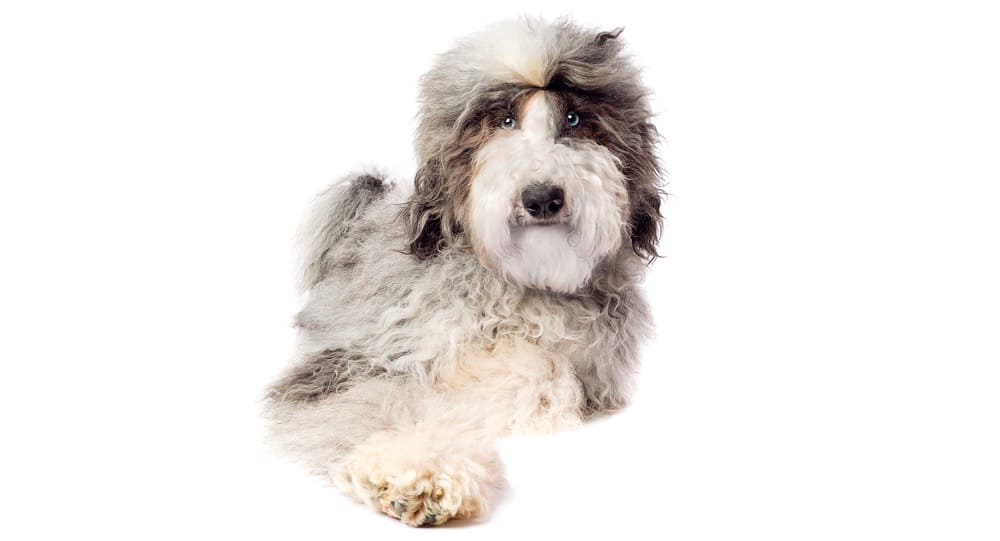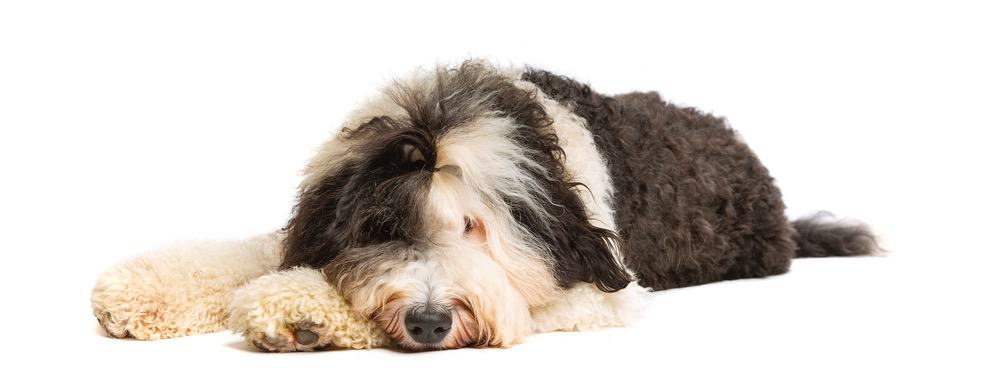Sheepadoodle Growth Chart – Weight & Size Chart
Sheepadoodles are a mix of two purebred dogs, the Poodle, and the Old English Sheepdog. The Sheepadoodle growth chart shows the adult weight and height of the different sizes of Sheepadoodles.
On average, Sheepadoodles can weigh between 25 to 85 pounds with a height of between 15 and 27 inches.
This depends on which type of Sheepadoodle they are as there are four sizes including toy, mini, medium, and standard.
This article will give you more information about the growth of Sheepadoodles, health issues that can affect them, how to help them lose weight, and many more!
When Is A Sheepadoodle Full Grown?

Being a large breed, Sheepadoodles need more time to grow and strengthen their joints, bones, and muscles. So, when do Sheepadoodles stop growing?
On average, the standard Sheepadoodles take about 18 months to stop growing while the mini and toy Sheepadoodle take about one year to reach their adult weight and height.
Once they reach their adult height, they will continue to add weight due to forming muscles and filling out.
If your Sheepadoodle is growing too fast, your vet can give you solutions to prevent it because if this happens, your puppy can suffer from joint issues which can affect their overall wellbeing.
Sheepadoodle Size Chart
Keeping track of your puppy’s weight using a Sheepadoodle size chart will enable you to determine the amount of their daily food intake and help you pick out the right accessories and gear for them.
Generally, Sheepadoodles experience their fastest growth phase in the first 6 months of their lives and by this time they will reach half of their adult weight and then slowly increase in size.
Therefore, it is important to provide them with healthy nourishment to help them grow strong and healthy.
Mini Sheepadoodle Size
The mini Sheepadoodle reaches their full height between the ages of 7 and 8 months, then add more weight until they reach their adult size. They are fully grown at the age of 12 months and will weigh about 25 to 35 pounds.
Medium Sheepadoodle Size
Medium Sheepadoodles will reach their adult weight at around the age of one year and they will weigh between 35 and 55 pounds.
Standard Sheepadoodle Size
The standard Sheepadoodle is the largest of them all. They take about 16 to 18 months to achieve their adult weight of about 55 to 85 pounds.
Sheepadoodle Weight Chart
| Mini Sheepadoodle | Medium Shepadoodle | Standard Sheepadoodle | |
|---|---|---|---|
| Weight | 20 - 45 lbs | 40 - 55 lbs | 55 - 80 lbs |
| Height | 16 - 18 inch | 19 - 22 inch | 23 - 26 inch |
| Full Grown | 12 months | 12 months | 14 - 16 months |
How Big Do Sheepadoodles Get?
Are you wondering how big do Sheepadoodles get? Looking at the parents, paws, generation, and doing a DNA test can give you an idea of their size when they are fully grown.
Parents pass certain genetic traits to puppies such as size. The size of Sheepadoodles comes from their Poodle parent than the Old English Sheepdog parent.
If the paws of your puppy are unusually small, they will be a smaller dog as adults and if their paws are unusually large, they will grow bigger to fill out their legs and body. There are different generations of Sheepadoodles such as F1, F1B, F1BB, F2B, and F2BB.
The letter ‘F’ refers to ‘filial hybrid’ meaning that the puppy is a mixed breed of two purebreds. The number 1 to 3 refers to the generation where the puppy is from, whether first, second, or third.
The letter ‘B’ shows that the Sheepadoodle was backcrossed with one of the original purebreds.
A DNA test can also tell you the adult size of your puppy.
When fully grown mini Sheepadoodle weighs between 25 to 35 pounds, medium Sheepadoodle weighs around 35 to 55, and standard Sheepadoodle weighs around 55 to 85 pounds.
Standard Sheepadoodle stands at 23 to 27 inches, medium Sheepadoodle stands at 19 to 22 inches, and mini Sheepadoodle stands at 15 to 18 inches.
Sheepadoodle Growth Chart – What to Expect

The following is what to expect from a Sheepadoodle growth chart:
Birth – 2 Weeks
During this age, the puppy’s eyes and ears are closed. They cannot hear or see and depend on their mother for warmth because they cannot regulate their body temperature. They spend most of their time sleeping and eating.
3 Weeks – 12 Weeks
Their eyes and ears begin to open during the third week, and they begin to observe their littermates and mother and mimic sounds. You can start weaning them in the fourth week because their teeth are starting to come out.
At 8 weeks, they can move to their new home because they have learned to socialize with other people and dogs.
4 Months – 6 Months
This is the stage where your puppy starts becoming independent and confident and they will want to show dominance. This is the right time to start training your puppy on obedience. Give them more attention and continue socializing with them.
7 Months – 9 Months
This is the age to think about spaying or neutering your puppy, therefore, speak to your vet about it.
At this stage, your puppy has lots of energy and they need regular exercise to stay active and keep fit. Specialized training such as agility and service training can be introduced because their brain can retain more information.

10 Months – 12 Month
Continue providing safe levels of vigorous exercise and play and give them safe toys to keep them occupied and mentally stimulated. Some mini and toy Sheepadoodles reach their adult weight and height at this age.
Adult
When your Sheepadoodle is an adult, they are mentally and physically mature. All they need now is your care and attention as well as adequate exercise and nutritious food to keep them healthy.
Their mindset will start to settle down, but they still need the training to keep their brain active.
Sheepadoodle Height Chart
The height of a Sheepadoodle is measured where the shoulders are the highest. This area is referred to as the withers where the shoulders and the neck meet. Your puppy’s height is the distance between the ground and the withers.
To find your puppy’s height, let them stand straight next to a wall. Take a ruler and place it on top of the withers and mark where the ruler touches the wall.
Then measure from the ground to the mark using a measuring tape. This is your Sheepadoodle’s height.
On average, the height of Sheepadoodles ranges from 15 to 27 inches depending on the size.
Will Neutering/Spaying My Sheepadoodle Affect His Growth?
Spaying or neutering your Sheepadoodle should be done between the ages of 8 and 12 months. This is after the females have had their first heat and the males have reached puberty.
If these procedures are done too early, the growth of your Sheepadoodle can be affected because the growth plates have not closed, and they depend on the reproductive hormones to close.
There are several reasons to neuter or spay your Sheepadoodle. First, spaying reduces the risk of uterine infections, breast cancer, and prevents unwanted pregnancies. Neutering protects your puppy from testicular cancer, minimizes aggressive behavior, and prevents breeding.
Factors That Affect Sheepadoodle Puppy Growth
The following factors can affect the growth of your Sheepadoodle puppy:
Genetics & Gender
Like humans, dogs inherit certain traits from their parents, half from the mother and the other half from the father. Some traits may be expressed more than others such as the rate of growth.
Some puppies grow faster while others grow slowly. Therefore, to know how fast your puppy will grow, let your breeder give you the information about the parent’s growth rate.
For most dogs, whether mixed or purebred, males are usually heavier and taller than females, and Sheepadoodles are no exception.
Nutrition
Providing balanced and complete nutrition to your Sheepadoodle will ensure that they are not malnourished or obese. If they are malnourished, they may not reach their full potential for weight and height and may experience stunted growth.
Since dogs do not have self-control, if you do not portion their food, they may add unnecessary weight and become obese, which can be detrimental to their health. This is because obesity is associated with diseases such as diabetes, heart disease, and elbow and hip dysplasia.
Physical Activity & Health
Health and physical activity are other factors that can affect the growth of your Sheepadoodle puppy.
Adult Sheepadoodles need 1 hour of exercise daily while puppies should be taken for walks based on their age. The general rule is 5 minutes of walking for every month of their age until they reach one year old.
Sheepadoodles can live long and happy for around 12 to 15 years and do not need special care. However, there are health conditions that can affect them as a breed such as Addison’s disease, ear infections, and hip dysplasia.
Goldendoodle vs Sheepadoodle Size
Goldendoodles and Sheepadoodles are similar in size across each size, whether it be mini, medium, or standard.
Mini Goldendoodle weighs between 25 to 35 pounds with a height of 15 to 17 inches, medium Goldendoodles weigh between 35 to 50 pounds with a height of around 17 to 20 inches, and standard Goldendoodle weighs between 50 to 90 pounds with a height of around 20 to 26 inches.
On the other hand, mini Sheepadoodle weighs between 25 to 35 pounds with a height of 15 to 18 inches, medium Sheepadoodle weighs between 35 to 55 pounds with a height of 19 to 22 inches, and standard Sheepadoodle weighs between 55 to 85 pounds with a height of 23 to 27 inches.
How To Properly Weigh And Measure A Sheepadoodle?
Ensuring that the weight of your Sheepadoodle is ideal for their age is crucial in keeping them healthy and prolonging their life.
Diseases such as diabetes, heart disease, joint damage, blood pressure, and digestive disorders are associated with weight gain.
Therefore, it is recommended that you help your puppy maintain a healthy weight. Weighing your puppy every 6 months using a bathroom scale will ensure that you are monitoring their weight.

To find the weight of your Sheepadoodle at home, first, weigh yourself and then weigh yourself while holding your puppy. The difference between the two numbers is your Sheepadoodle weight.
Sheepadoodle Body Condition Score (BCS)
Since dogs vary differently in shape and size, vets use the Body Condition Score to determine the level of fat in them.
The BCS makes it easy for dog owners to come up with an exercise and diet plan to suit their dog’s lifestyle, activity level, and body.
The two scales of BCS are 1-9 and 1-5. To assign a score to your Sheepadoodle, you need to look at their ribs, abdomen, waist, hip bones, spin, and muscle covering.
When your puppy has a healthy weight, their BCS score is 3/5 or 5/9. This is where you can feel your puppy’s ribs with your fingers, see their tummy tuck from the side and waistline from above.
What If My Sheepadoodle Is Not the Right Weight
Is your Sheepadoodle overweight or underweight? The first thing you need to do is take them to the vet to be checked out if they have any illness. When cleared, you can help your puppy lose or gain weight at home.
Help your puppy gain weight through the following steps:
- Increase the daily caloric intake.
- Switch to premium dog foods with all the necessary nutrients.
- Add supplements to the diet with the guidance of the vet.
- Help your puppy lose weight by doing the following:
- Measure your puppy’s food to know exactly how much they are eating.
- Reduce the daily caloric intake.
- Give smaller and healthier treats such as broccoli, cucumber, baby carrots, and apple slices.
- Increase the exercises such as going for long walks, hikes, and jogs.
Sheepadoodle Genetics and Common Health Problems
Sheepadoodles are not very sickly because they are a mixed breed and are considered to be healthier than purebred dogs.
The diverse gene pool that mixed breeds are associated with makes them have fewer hereditary health conditions. The following are some of the health issues that Sheepadoodles are genetically predisposed to:
Ear Infections – Sheepadoodles are prone to ear infections because of their floppy ears that trap moisture facilitating the growth of bacteria that causes infections.
Entropion – this is a condition where the eyelid rolls inward.
Atrial Septal Defect – this is a condition where there is a hole in the heart affecting the flow of blood.
Tricuspid Valve Dysplasia – this is where the heart is not formed properly causing issues with circulation.
Corneal Dystrophy – this is the clouding of the cornea which can lead to blindness.
Sebaceous Adenitis – this condition causes scaling on the skin.
Addison’s Disease – affects the adrenal glands.
Hip Dysplasia – leads to deterioration and friction in the joints.
Optic Nerve Hypoplasia – another condition that affects the eyes.





